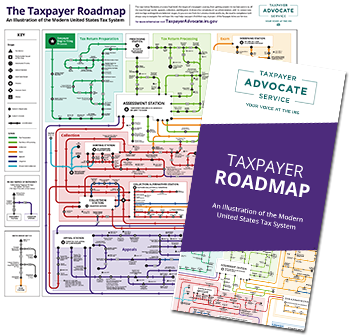Notice CP14
Balance Due $5 or More, No Math Error
View our interactive tax map to see where you are in the tax process. It could help you navigate your way through the IRS.
View our interactive tax map to see where you are in the tax process. It could help you navigate your way through the IRS.

Notice of Tax Due and Demand for Payment, Notice CP14, Balance Due $5 or More, No Math Error, is the first and most common notice sent to taxpayers. The notice advises the taxpayer that there is a tax due, states the amount of tax, including interest and penalties, and requests payment within 21 days. If the taxpayer does not pay the amount due within 60 days, the IRS can proceed with collection activity, including the filing of a Notice of Federal Tax Lien.
This notice or letter may include additional topics that have not yet been covered here. Please check back frequently for updates.
If you have a balance on your tax account, you’ll get a notice letting you know how much you owe, when it’s due, and how to pay.
Your return was filed and the balance owing and/or penalties and interest have not been paid yet. As a result, you have a balance on your tax account. This notice is being sent to you to let you know how much you owe, when it is due, and how to pay.
The first thing to do is to check the return address to be sure it’s from the Internal Revenue Service and not another agency.
If it’s from the IRS, the notice will have instructions on how to respond. If you want more details about your tax account, you can order a transcript. Also, review your notice or letter to see if there is a specific website link to visit for additional information. This is usually located at the end of the notice or letter.
If it’s from another agency, such as a state tax department, you’ll need to call that office for an explanation.
If the letter is from the Department of the Treasury Bureau of the Fiscal Service, these notices are often sent when the IRS takes (offsets) some or part of your tax refund to cover another, non-IRS debt such as student loan debt. The Bureau of the Fiscal Service only facilitates the transfers of the refund between the IRS and the agency that the balance is owed to — it won’t have information about your IRS account or where the money is being sent.
If you disagree with the notice, call the IRS at the toll-free number on the top right corner of your notice. Please have your paperwork (such as cancelled checks, amended return, etc.) ready when you call. See also Publication 5, Your Appeal Rights and How to Prepare a Protest If You Don’t Agree.
If you can’t pay the full amount by that date, you need to figure out what payment options might work for your situation, and contact the IRS to set up a payment plan or discuss other ways to address your balance.
Being proactive in addressing the tax debt may prevent additional penalty and interest charges and eliminate the need for the IRS to take action to collect the balance. For specifics, see I got a notice from the IRS.
Understanding your notice or letter
For more specifics on your notice, visit Understanding your CP14 Notice and Understanding your IRS Notice or Letter on IRS.gov.
Get Help topics
Browse common tax issues and situations at TAS Get Help
If you still need help
The Taxpayer Advocate Service is an independent organization within the IRS that helps taxpayers and protects taxpayers’ rights. We can offer you help if your tax problem is causing a financial difficulty, you’ve tried and been unable to resolve your issue with the IRS, or you believe an IRS system, process, or procedure just isn’t working as it should. If you qualify for our assistance, which is always free, we will do everything possible to help you.
Visit dev.taxpayeradvocate.irs.gov or call ![]() 1-877-777-4778.
1-877-777-4778.
Low Income Taxpayer Clinics (LITCs) are independent from the IRS and TAS. LITCs represent individuals whose income is below a certain level and who need to resolve tax problems with the IRS. LITCs can represent taxpayers in audits, appeals, and tax collection disputes before the IRS and in court. In addition, LITCs can provide information about taxpayer rights and responsibilities in different languages for individuals who speak English as a second language. Services are offered for free or a small fee. For more information or to find an LITC near you, see the LITC page on the TAS website or Publication 4134, Low Income Taxpayer Clinic List.
Additional Resources
Notice of Tax Due and Demand for Payment
Balance Due $5 or More, No Math Error, Notice CP14